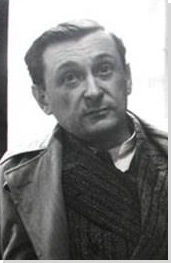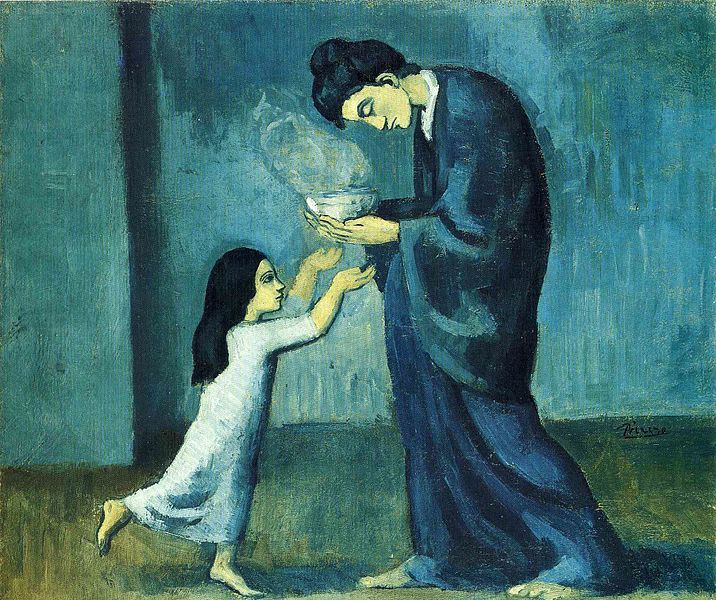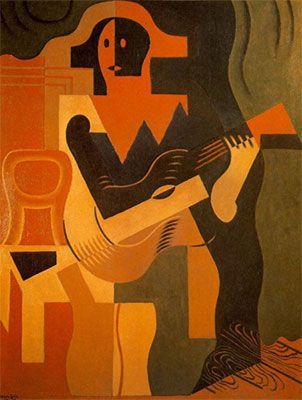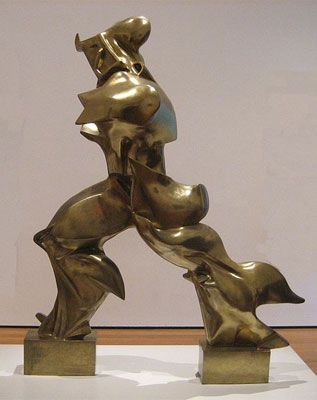Summary of Jacques Lipchitz
Lithuanian and Jewish, the refugee artist Jacques Lipchitz arrived in Paris at precisely the right time: when the early-20th-century European avant-garde was shaking up the art world and Cubism was born. When we think of Cubist sculpture, the works of Lipchitz emerge as exemplars of the style translated into three dimensions. Later, the second time Lipchitz fled for his life at the beginning of WWII, he left behind a less abstract style and, in a major career-changing transformation, began producing larger-scale sculptures in bronze. Later still, the work of the ever-dynamic Lipchitz had become increasingly emotionally expressive, often incorporating themes from Judaism. At the end of his long lifetime and multinational trek, Lipchitz may be regarded as one of the foremost contributors to the Cubist style and to modern sculpture.
Accomplishments
- Lipchitz and fellow sculptor, Alexander Archipenko, succeeded where Cubist painters had achieved only moderate success - he transformed Cubist themes into sculptural works that display a sense of refinement and cohesion. Of the two artists, the works of Lipchitz were less abstract and rarely incorporated bright colors.
- The works that Lipchitz referred to as "transparents" were given that name because they were pierced by abundant negative space. Basically, you could see right through them, or through parts of them. He used this strategy to promote the sculptures' interaction with their surroundings. They were frequently displayed outdoors, so the landscape became an important component of a work.
- Lipchitz early, classical training and adept draftsmanship are evident in the emotionally charged, large bronze pieces he began producing later in his career. Themes deriving from Biblical tales and Greek mythology called for a more curvilinear and naturalistic style. Sweeping lines and variations in depth belie the influence of Cubism but the large, dramatic pieces that are made even more powerful by nature of their size as if to evoke the magnitude of the horrors of World War II.
The Life of Jacques Lipchitz

The ever-driven creator, Lipchitz said: "All my life as an artist I have asked myself: What pushes me continually to make sculpture? I have found the answer. Art is an action against death. It is a denial of death."
Important Art by Jacques Lipchitz
Pregnant Woman
This early work by Lipchitz demonstrates both his traditional artistic training and the incipient signs of his transition away from art school orthodoxy. Lipchitz received a thorough education in traditional sculptural processes, from drawing classical works to mocking up compositions in clay, to creating full plaster models. Most classically trained artists would give their models to a craftsman to carve in stone or cast in bronze. However, Lipchitz' Pregnant Woman remains in its plaster stage and has been treated as a finished work.
Although it is technically skilled, this work is very unlike the classical sculptures Lipchitz would have studied. Instead, it shows the influence of alternative types of sculpture such as medieval pieces or works from the African continent that, at the time, were being brought to Europe and characterized as "primitive". The figure's flat facial features and the unusual position of her arms, along with her designation as a pregnant woman, all point to an anti-classicizing tendency. This is indicative of Lipchitz' increasing regard for the work of contemporaneous, avant-garde artists in Paris who were predominantly interested in works of art from outside the classical canon.
Plaster - Collection of the Tate, United Kingdom
Sculpture
One of Lipchitz' earliest abstract sculptures, the composition is based on the form of a human figure seated at a table. He claimed that at the time the sculpture was produced that he was engaged in "building up and composing the idea of a human figure from abstract sculptural elements of line, plane and volume."
Lipchitz presents the human figure as comprised of a variety of planes and surfaces, making use of the space surrounding the sculpture and encouraging the viewer to look at the work from multiple angles. In this way, the artist is rejecting the concept of the ideal viewpoint which is fundamental to classical sculpture.
Lipchitz originally modelled this work in clay before having the final piece executed by a stone carver he employed to assist him. When working on these "abstract architectural" sculptural pieces, Lipchitz insisted that they required the "architectural mass of stone" in order to be fully realized.
Limestone - Collection of the Tate, United Kingdom

Seated Man with a Guitar
Seated Man with a Guitar is one of Lipchitz' most mature Cubist works. While it is less abstract than earlier works such as Sculpture (1915-16), Lipchitz manages to reduce the human figure into a few distinct shapes while maintaining a degree of naturalism. The simple forms that make up the guitar are integrated with the figure's body, fusing the two as though they are one and the same object. In this way, Lipchitz succinctly conveys the notion of a performance in which the musician and instrument are of equal importance.
Guitars were frequent features of Cubist paintings and sculptures. There are various theories pertaining to exactly why the instrument was so widely depicted by Cubist artists, but it is perhaps partly because the guitar is held so close to the body, integrated and enlivened by it, when it is played. This necessary intimacy between the musical instrument and the musician inspired artists such as Lipchitz to collapse the space between the figure and the object and unify them, which was a key aim of the Cubist movement.
Critic Christopher Green describes how, in order to compose this work, Lipchitz constructed and projected volumes "outwards from an imagined core" in order to achieve an "expansive, outward-oriented occupation of space." This creative use of the space surrounding the sculpture is a key feature of Lipchitz' sculptural work.
Plaster, paint, varnish - Kröller-Muller Museum, The Netherlands
Seated Man (Meditation)
By the mid-1920s, Lipchitz had moved away from the Cubist style that had characterized his work for two decades. While he continued to produce simplified, semi-abstract compositions, frequently referring to the human form for inspiration, many of the formal features of Cubism disappeared. He spoke of breaking free from "the iron rule of syntactical cubist discipline" in the hopes of discovering a new creative mode. One of the fruits of this labor was Seated Man, which is a highly emotive work.
Lipchitz described this piece as depicting "a weary man, slumped in a chair, his arm supporting his nodding, drowsy head." In order to achieve this effect, Lipchitz makes use of the mirroring of geometrical shapes to form the figure's arms, which sweep around the body in an S shape. Although the figure has a sense of solidity and mass, its core is pierced by a hole, creating a sense of balance to the weightiness of the material and the mood. Lipchitz' innovation was to utilize this negative space as an integral part of the sculptural form.
Although Seated Man is produced in a style that clearly recalls the innovations of Cubism and abstraction, it also serves as a visual reference to Auguste Rodin's famous work, The Thinker (1902). Indeed, Rodin's influence was palpable in Paris in the first decades of the 20th century, although many members of the avant-garde were contemptuous of his popularity. However, at this point in his career, Lipchitz' respect for the fervent, expressive style of the renowned sculptor and so-called "father of modern sculpture" is surely echoed in this work.
Bronze - The Metropolitan Museum of Art, New York
The Cry (The Couple)
By the end of the 1920s, Lipchitz had achieved commercial success and was thus able to work on larger pieces, which could be cast in bronze, an expensive material. With The Cry (The Couple), he continued to explore the limits of the casting process by including large openings in the mass of the sculpture through which the viewer may peer. This feature makes such works particularly suited to being displayed outdoors, as the landscape can be seen through the sculpture and even becomes an interactive component of the piece. Lipchitz referred to these sculptures as "transparents" because they defied sculptural conventions in the sense that, while comprised of mass, they actively engaged with negative space and the viewer could literally see through them.
The Cry (The Couple) depicts two serpentine figures locked in an erotic embrace. Although the male and female figures are evidently discrete forms, the composition emphasizes the eponymous notion of coupling through their embrace, and creates a unified whole. Lipchitz originally titled this work The Couple, but he later chose to rename it The Cry. This adjustment reflects the tense nature of the ecstatic sexual moment, but both the sculpture and the title are ambiguous about whether it is agony or pleasure that is being depicted.
The overtly sexual theme of this work is emblematic of Lipchitz' departure from the more common subjects that dominated his earlier work such as standing or seated figures or musical instruments that were favored by the Cubists. By the early 1930s, he had begun to explore a range of themes along biblical and mythological lines.
Bronze - Riijksmuseum, Amsterdam
The Prayer
Sculpted in the midst of the Second World War, The Prayer served as a direct expression of Lipchitz' horror upon learning of the Nazi's concentration camps. As a Jew, he had been forced to flee Paris for New York a few years earlier and it was in the United States that he rediscovered his religion and the subject matter of his sculptures became increasingly concerned with religion and Judaism.
This particular work depicts an elderly man in traditional ritual garb, reciting a prayer. The figure is surrounded by projecting organic forms, flames, or foliage suggestive of the Burning Bush. As a part of the ritual, the man flings a large rooster over his head while in his other hand he holds a prayer book. The composition is complex and, on first sight, perplexing. It is, however, deeply emblematic of the complexity of the prayer ritual itself and functions both as the manifestation of a prayer for Holocaust victims and of Lipchitz' own process of praying through sculpting. Indeed, the artist explained that he had wept throughout the production of the work; for Lipchitz, the sculptural process provided a sort of spiritual and emotional catharsis.
By the mid-1940s, Lipchitz was developing his own style of expressionism, producing works that were charged with emotion. Lipchitz sought a sculptural form that could help him both to express his own feelings of sorrow and to comment on the tumultuous state of the world.
Bronze - The Philadelphia Museum of Art, Philadelphia

Prometheus Strangling the Vulture
This work draws on a well-known Greek myth in which the Titan Prometheus sympathizes with the plight of humans and steals fire from the gods for them. As punishment, he is tied to a rock and a vulture (or, in some versions, an eagle representing Zeus) consumes his liver. Each day, the liver is regenerated and Prometheus' agony repeated. According to the myth, Prometheus is eventually freed by Hercules who kills the bird. However, in Prometheus Strangling the Vulture, Lipchitz depicts the Titan breaking free of his chains and wrestling the bird that has caused him so much pain. Created at the height of World War II, the sculpture is in part symbolic of humanity's struggle against evil and particularly against the persecution of Jews by the Nazis.
The sculpture was originally produced in plaster and that version was on display in Philadelphia in 1952 when Lipchitz' New York studio burned, destroying all his works in progress. The Philadelphia Museum of Art purchased the work at the highest price it had paid for a work by a living sculptor at that time. Following its purchase, the piece was cast in bronze under Lipchitz' supervision. Prometheus Strangling the Vulture is installed near the entrance to the museum. Expressive and distinctly organic, from a formal perspective the work shares few stylistic similarities to Lipchitz' early works although it maintains the same strong sense of mass and volume projecting from a central core.
Bronze - The Philadelphia Museum of Art, Philadelphia
Biography of Jacques Lipchitz
Childhood
Jacques Lipchitz was born Chaim Jacob Lipschitz to a Jewish family in Druskininkai, a small town in the former Russian empire (modern-day Lithuania). His father, Abraham Lipchitz, a building contractor, was rarely home, leaving the rearing of Lipchitz largely to his mother Rachel. In keeping with his father's wishes, Lipchitz began studying engineering. It was thanks to his mother's encouragement, however, that the young Lipchitz at age 17 gave up engineering and moved to Paris in 1908. Although his father was disappointed, Lipchitz later said that "after I went to Paris, my father forgave me and as long as he was able to, he contributed to my support."
Early Training
In Paris, Lipchitz adopted the French first name "Jacques" and enrolled in the École des Beaux-Art as well as the forward thinking Academie Julian. He soon made contact with members of some of the most avant-garde artistic groups of the period, which were flourishing in Paris. The young emigre became friends with ground-breaking artists such as Amedeo Modigliani, Pablo Picasso, Juan Gris, and Diego Rivera. He later recounted anecdotes about the relationships between these figures and the influence they exerted on one another and their work. He recalls in particular one occasion when the artist Juan Gris told him "about a bunch of grapes he had seen in a painting by Picasso. The next day," recalled Lipchitz, "these grapes appeared in a painting by Gris, this time in a bowl; and the day after, the bowl appeared in a painting by Picasso."
Mature Period
Under the influence of Picasso and Alexander Archipenko in particular, Lipchitz began creating his first Cubist sculptures in 1913. This was a particularly formative phase for the sculptor, as it was for so many artists living in Paris at that time. He later claimed that "the period during the First World War was a very exciting time in Paris, with artists, philosophers, and poets continually discussing and arguing about the work with which they were involved."

In 1916, Lipchitz and his new wife Berthe, a Russian poet, sat for one of Modigliani's best-known portraits. The couple is depicted in their Paris apartment, which had formerly been the home of the sculptor Constantin Brancusi. Curator Neal Benezra notes that Lipchitz and Modigliani, although close friends, could not have been more different. "Lipchitz," explains Benezra, was "a model of artistic industry and traditional values" whereas Modigliani," he continues, "was the stereotypical peintre maudit ("cursed" or "doomed painter"), tragically doomed by his own vices."
Late Period

In 1925 Lipchitz became a French citizen, living and working on the outskirts of Paris in a house he commissioned from the radical Swiss-French, architect Le Corbusier (born Charles-Édouard Jeanneret-Gris). During the 1930s, Lipchitz's work was exhibited internationally and he received the gold medal for sculpture at the 1937 Paris Exposition. However, when the Germans occupied Paris in 1940, the artist's Jewish heritage placed him in grave danger and he was forced to flee to the United States, taking up residence in New York City. He later said of this upheaval, "I had been forced to leave everything - my studio, my house, my collection - and I was reconciled to the idea that everything was lost or destroyed. I had begun a new life in the United States." The persecution of Jewish people by the Nazis caused Lipchitz to engage more actively in his religion and in his later years he sought the spiritual help of a Rabbi. Lipchitz eventually found some religious catharsis through the sculpture that he created in the 1940s.
When they visited Paris for an exhibition after World War II, his wife Berthe informed Lipchitz that she didn't wish to return to the USA. The couple was subsequently divorced and he continued to live in America, settling in Hastings-on-Hudson, a northern suburb of New York City. Soon after, he met and married Yulla Haberstadt, a sculptor from Berlin. In 1958, he suffered a major hemorrhage due to stomach cancer. Although he survived it, the illness comprised a significant setback for the artist. However, he continued to produce art until his death on the Italian island of Capri in 1973, where he had a villa and studio near a respected foundry. After his death his body was flown to Jerusalem for burial.
The Legacy of Jacques Lipchitz
Lipchitz will be remembered for his achievements in the development of Cubism, particularly in his transformation of the formal characteristics of the style from painting into three-dimensional works. Along with Picasso, his work influenced many artists, including Henri Laurens and Umberto Boccioni, who was instrumental in developing Italian Futurist sculpture. Lipchitz' influence is particularly notable in the work of his student.
Influences and Connections

-
![Cubism]() Cubism
Cubism ![Modern Sculpture]() Modern Sculpture
Modern Sculpture
Useful Resources on Jacques Lipchitz
- Jacques Lipchitz: His SculptureBy A.M. Hammacher
- Jacques Lipchitz: The First Cubist SculptorBy Cathy Putz
- Jacques Lipchitz: A Life in SculptureOur PickBy Alan Wilkinson
 Ask The Art Story AI
Ask The Art Story AI




















